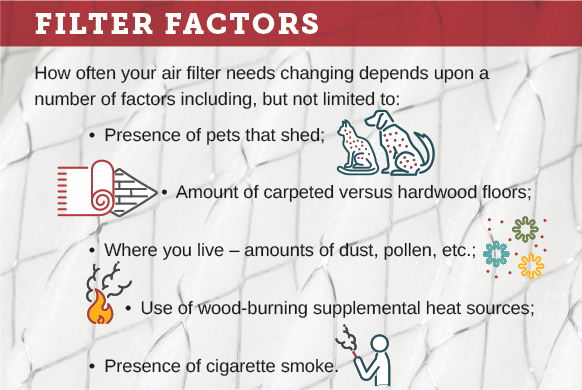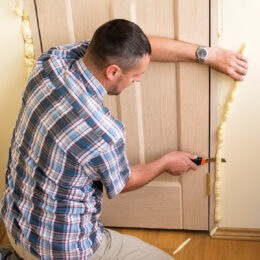By Garrett Keiser
Forced air heating, ventilating and air conditioning (HVAC) systems require effective air filtration for optimum energy efficiency, maintaining clean(ish) ductwork and good indoor air quality.
Air filters should be changed regularly. How often they need changing depends upon a number of factors (see graphic below).
There are more choices of filters than you can shake a stick at. Fortunately, they can be broken down into two nicely defined categories, making the selection process manageable. The two are:
• Permanent or disposable;
• Flat or pleated media (with a handy MERV rating).
Disposable filters are the most prevalent. Some in the flat media group look like they will stop only particles larger than a golf ball. They have flimsy cardboard frames and a thin, flat mesh you can easily see through. While they are cheap, don’t waste your money. Your HVAC system and lungs deserve better.
Pleated filters perform better using media you cannot see through. While they look impervious, air can move through under pressure leaving its airborne cargo trapped. Pleated filters are a better choice, in my experience.
Remember MERV? That is a rating system that tells you how effective a filter is at trapping particles. Standing for “Minimum Efficiency Reporting Value,” it’s a measure of efficiency. The scale runs from 1 to 16 and is based on trapping particles 3-10 microns in diameter. Research shows that residential filters with a MERV rating between 7 and 13 are likely to be as effective as true HEPA (high-efficiency particulate arrestance) filters. This class of filter is used in clean room manufacturing and at the extreme end can trap particles much smaller than the diameter of a human hair, as small as 1 micron.
So, should you jump in and grab a supply of high MERV filters? Not without some research. All filters increase resistance to air flow. HVAC systems are designed to operate at a particular pressure and should support MERV ratings of one to four. A higher MERV value increases resistance, making the system work harder. It loses efficiency and increases wear on operating components.
So, how do you decide which level of filter to use? If you have your system’s operating manual or can grab it online, check for recommendations. Otherwise, my advice is to go with a decent (MERV 3 to 5) pleated filter and check it once a month to see how it is performing. Also check to see if the dust inside decreases.
Spend a little more and breathe a lot easier with a regular schedule of air filter replacement. A simple change that pays big dividends.
GARRETT KEISER is energy advisor at Heartland REMC




